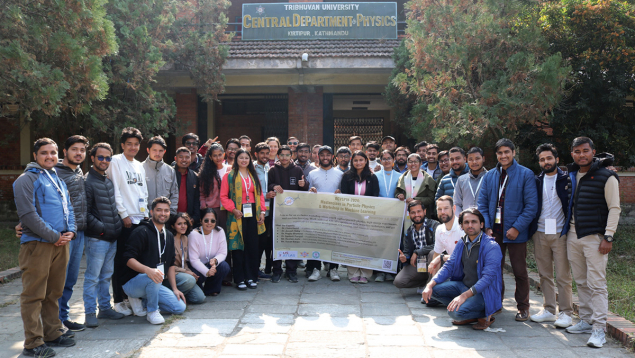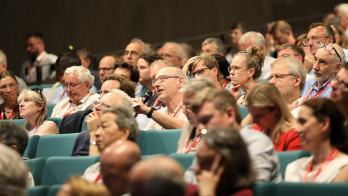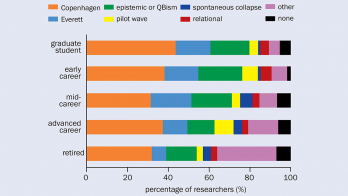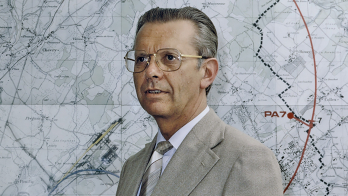
After winning the Nobel Prize in Physics in 1979, Abdus Salam wanted to bring world-class physics research opportunities to South Asia. This was the beginning of the BCSPIN programme, encompassing Bangladesh, China, Sri Lanka, Pakistan, India and Nepal. The goal was to provide scientists in South and Southeast Asia with new opportunities to learn from leading experts about developments in particle physics, astroparticle physics and cosmology. Together with Jogesh Pati, Yu Lu and Qaisar Shafi, Salam initiated the programme in 1989. This first edition was hosted by Nepal. Vietnam joined in 2009 and BCSPIN became BCVSPIN. Over the years, the conference has been held as far afield as Mexico.
The most recent edition attracted more than 100 participants to the historic Hotel Shanker in Kathmandu, Nepal, from 9 to 13 December 2024. The conference aimed to facilitate interactions between researchers from BCVSPIN countries and the broader international community, covering topics such as collider physics, cosmology, gravitational waves, dark matter, neutrino physics, particle astrophysics, physics beyond the Standard Model and machine learning. Participants ranged from renowned professors from across the globe to aspiring students.
Speaking of aspiring students, the main event was preceded by the BCVSPIN-2024 Masterclass in Particle Physics and Workshop in Machine Learning, hosted at Tribhuvan University from 4 to 6 December. The workshop provided 34 undergraduate and graduate students from around Nepal with a comprehensive introduction to particle physics, high-energy physics (HEP) experiments and machine learning. In addition to lectures, the workshop engaged students in hands-on sessions, allowing them to experience real research by exploring core concepts and applying machine-learning techniques to data from the ATLAS experiment. The students’ enthusiasm was palpable as they delved into the intricacies of particle physics and machine learning. The interactive sessions were particularly engaging, with students eagerly participating in discussions and practical exercises. Highlights included a special talk on artificial intelligence (AI) and a career development session focused on crafting CVs, applications and research statements. These sessions ensured participants were equipped with both academic insights and practical guidance. The impact on students was profound, as they gained valuable skills and networking opportunities, preparing them for future careers in HEP.
The BCVSPIN conference officially started the following Monday. In the spirit of BCVSPIN, the first plenary session featured an insightful talk on the status and prospects of HEP in Nepal, providing valuable insights for both locals and newcomers to the initiative. Then, the latest and the near-future physics highlights of experiments such as ATLAS, ALICE, CMS, as well as Belle, DUNE and IceCube, were showcased. From physics performance such as ATLAS nailing b-tagging with graph neural networks, to the most elaborate mass measurement of the W boson mass by CMS, not to mention ProtoDUNE’s runs exceeding expectations, the audience were offered comprehensive reviews of the recent breakthroughs on the experimental side. The younger physicists willing to continue or start hardware efforts surely appreciated the overview and schedule of the different upgrade programmes. The theory talks covered, among others, dark-matter models, our dear friend the neutrino and the interactions between the two. A special talk on AI invited the audience to reflect on what AI really is and how – in the midst of the ongoing revolution – it impacts the fields of physics and physicists themselves. Overviews of long-term future endeavours such as the Electron–Ion Collider and the Future Circular Collider concluded the programme.
BCVSPIN offers younger scientists precious connections with physicists from the international community
A special highlight of the conference was a public lecture “Oscillating Neutrinos” by the 2015 Nobel Laureate Takaaki Kajita. The event was held near the historical landmark of Patan Durbar Square, in the packed auditorium of the Rato Bangala School. This centre of excellence is known for its innovative teaching methods and quality instruction. More than half the room was filled with excited students from schools and universities, eager to listen to the keynote speaker. After a very pedagogical introduction explaining the “problem of solar neutrinos”, Kajita shared his insights on the discovery of neutrino oscillations and its implications for our understanding of the universe. His presentation included historical photographs of the experiments in Kamioka, Japan, as well as his participation at BCVSPIN in 1994. After encouraging the students to become scientists and answering as many questions as time allowed, he was swept up in a crowd of passionate Nepali youth, thrilled to be in the presence of such a renowned physicist.
The BCVSPIN initiative has changed the landscape of HEP in South and Southeast Asia. With participation made affordable for students, it is a stepping stone for the younger generation of scientists, offering them precious connections with physicists from the international community.







